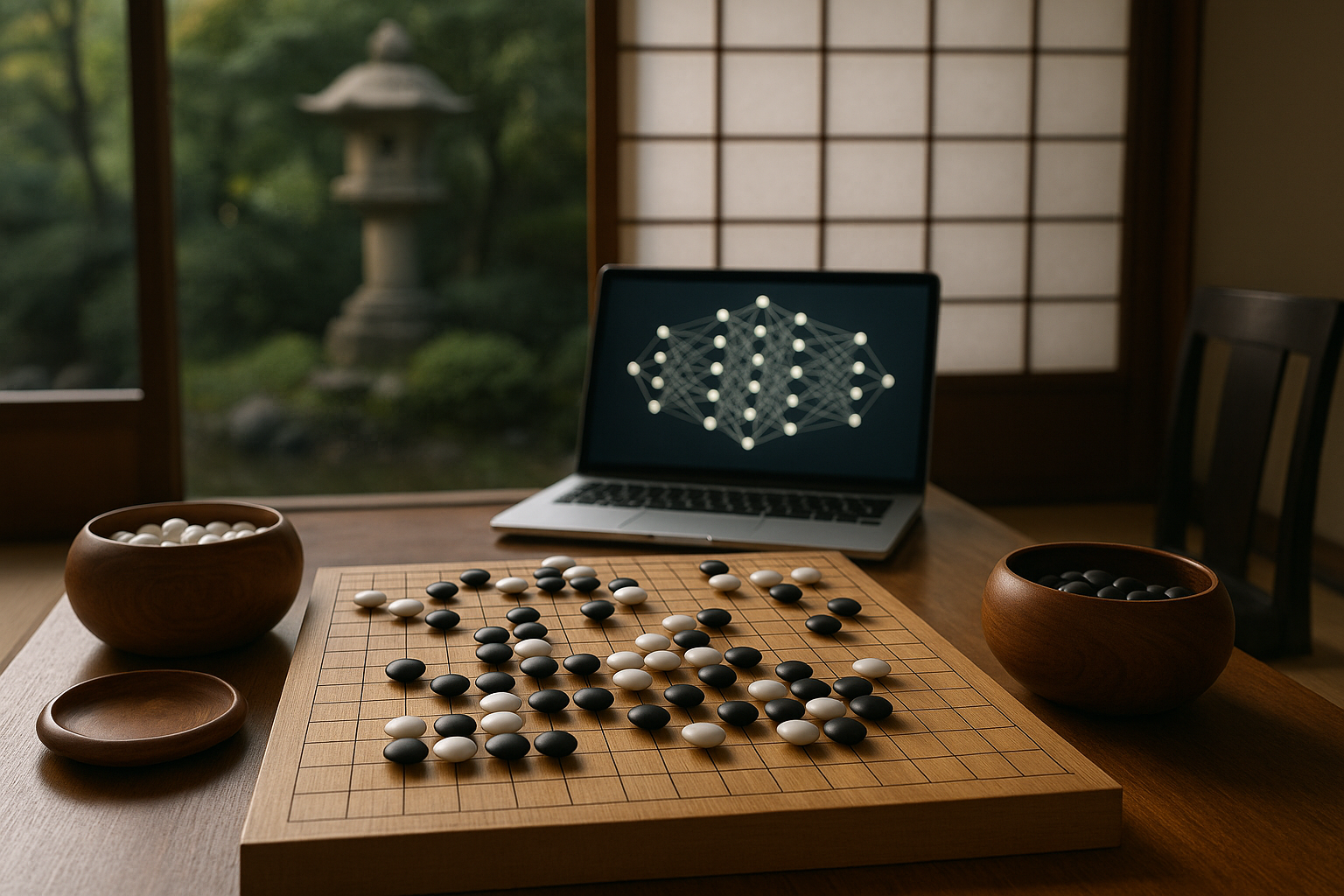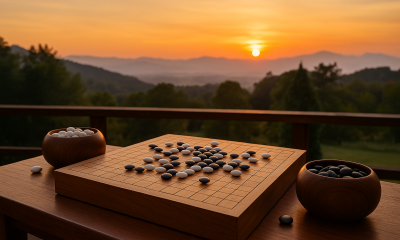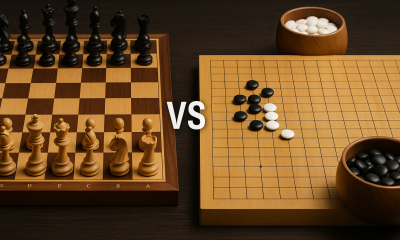News
Go: The Ancient Game of Stones and Strategy

Few games capture the elegance of human thought like Go—known as weiqi in China, igo in Japan, and baduk in Korea. With origins tracing back thousands of years, it’s not just a pastime but a reflection of philosophy, mathematics, and strategy. From the imperial courts of ancient China to the labs of modern artificial intelligence, Go has evolved while preserving its timeless simplicity.
1. Ancient Origins and Legendary Beginnings
According to Chinese legend, Emperor Yao created Go to teach his son patience and balance—a story recorded in ancient texts, though likely myth. What’s clear is that Go’s roots are extraordinarily deep. Archaeological and literary evidence suggests the game may date back over 4,000 years, making it older than chess. Historians estimate its emergence during the Zhou dynasty, when scholars used it as a metaphor for warfare and moral balance, as noted in the Encyclopaedia Britannica.
By the 5th century CE, Go had spread to Korea and Japan, where it became deeply embedded in the samurai ethos and was studied alongside martial arts and calligraphy. The game’s expansion and codification across Asia are documented in the History of Go, which outlines how cultural exchange and imperial diplomacy carried Go beyond China’s borders.
One of the most remarkable artifacts from this era is the Dunhuang Go Manual, discovered in the Mogao Caves and dated to the 6th century. It’s one of the earliest known instructional documents in any game and provides a glimpse into the strategic sophistication of early Go masters. You can learn more about it in the Dunhuang Go Manual entry.
2. The Rules: Simplicity Breeding Complexity
The beauty of Go lies in its simplicity. Two players take turns placing black and white stones on the intersections of a grid. The goal? Control more territory than your opponent. Yet beneath these basic rules lies an ocean of complexity—so vast that no human or machine has ever truly “solved” it.
Board and Stones
The standard Go board contains 19×19 intersections, though smaller 9×9 or 13×13 versions are often used for learning. Players alternate turns, placing one stone at a time. Once set, stones remain unless captured. A detailed breakdown of the rules is available on Wikipedia’s Rules of Go page.
Liberties, Captures, and Ko
Each stone must maintain at least one adjacent empty space—called a liberty. When all liberties are occupied by the opponent, the group is captured. To prevent infinite repetition, the ko rule forbids recreating a previous board position. This simple restriction creates deep layers of tactical nuance.
Scoring and Rule Variants
Two main scoring systems exist. In territory scoring, you count the number of empty intersections you surround, while in area scoring you count both stones and territory. The differences are small but philosophically fascinating—each system changes the tempo and style of play. These are explained in detail in the British Go Association’s overview.
Komi, Handicap, and Ranks
To balance the first-move advantage, White receives komi, typically around 6.5 points. When players of unequal strength compete, the weaker player may receive handicap stones at the start. Go uses the kyu/dan ranking system—similar to martial arts—where amateurs progress through kyu ranks toward 1-dan and professionals climb through multiple dan levels.
Strategic Depth
Go embodies both local tactics and global strategy. Concepts such as sente (initiative), aji (latent potential), and fuseki (opening patterns) define advanced play. As explained in Sensei’s Library, true mastery requires balancing attack and defense while managing the whole board’s flow—a perfect metaphor for life itself.
3. Cultural and Institutional Growth
Imperial Japan and the Rise of Go Schools
While Go’s roots are Chinese, its institutional structure matured in Japan. During the Tokugawa era (1603–1868), the shogunate officially recognized four major Go houses: Hon’inbō, Inoue, Hayashi, and Yasui. These schools trained professionals, codified strategy, and established the Meijin title, the most prestigious rank of the time. Their influence still echoes in the modern Nihon Ki-in (Japan Go Association).
Among the most celebrated players in history is Hon’inbō Shūsaku, whose intuitive yet powerful style inspired generations. His famous “Ear-Reddening Game,” immortalized in Go lore, is often cited as a pinnacle of human strategic artistry. Ear-reddening Game
Modern Expansion and Globalization
After World War II, Go’s influence spread worldwide through cultural exchange and publications. Western enthusiasts began forming clubs and federations, and by the late 20th century, Go was played competitively on every continent. The International Go Federation now includes over 75 member countries.
The 1990s saw a cultural resurgence thanks to the manga and anime Hikaru no Go, which introduced the game to millions of new players. Its impact on global interest is documented on Wikipedia’s Hikaru no Go page.
4. Go Meets Artificial Intelligence
From Human Intuition to Machine Mastery
Go has long been considered a frontier for AI research. Unlike chess, whose branching possibilities are manageable with brute-force search, Go’s 19×19 board has more configurations than atoms in the observable universe. Early programs relied on pattern recognition and Monte Carlo simulations but remained far weaker than top humans until the 2010s.
The AlphaGo Revolution
That changed in 2016 when DeepMind’s AlphaGo defeated Lee Sedol, one of the world’s strongest professionals, by four games to one. The victory demonstrated that deep neural networks—combined with Monte Carlo tree search—could achieve and even surpass human intuition.
AlphaGo’s creativity stunned experts. Moves once considered “wrong” became revelations. Its play inspired countless analyses and reshaped Go theory. The full story is chronicled in the AlphaGo versus Lee Sedol documentation.
From AlphaGo to MuZero
After AlphaGo, DeepMind continued its work with AlphaZero and later MuZero, an algorithm that learns to play games without being told their rules. By observing its own experience, MuZero developed an internal model of game dynamics and matched AlphaZero’s performance in Go, chess, and shogi. DeepMind explained the underlying science in its MuZero research blog.
The innovation was so profound that Nature published a paper detailing how MuZero plans moves by simulating future outcomes rather than memorizing past ones. It represents a step toward general reasoning—learning the rules of the world by observation, just as humans do.
The Role of KataGo and Open AI Research
Following DeepMind’s lead, open-source projects such as KataGo advanced the field further, offering public access to superhuman Go engines. Players now use AI to analyze games, test strategies, and even train against customized difficulty levels. This democratization of AI tools has elevated play at every level, from beginner to professional.
AI’s New Challenges
Even superhuman Go AIs have weaknesses. Researchers have uncovered adversarial “blind spots” that can trick engines like KataGo into catastrophic errors—a phenomenon highlighted in this arXiv paper. Such findings remind us that intelligence, whether human or artificial, remains vulnerable to deception.
5. The Enduring Appeal of Go
Despite—or perhaps because of—AI’s dominance, Go’s human community is thriving. The relationship between people and machines has become symbiotic. Professionals study AI-generated games for inspiration, while hobbyists use engines to improve their own intuition.
What keeps players returning to the board isn’t just competition, but contemplation. Go rewards patience, foresight, and humility. It offers lessons on restraint and balance that resonate beyond the board, echoing in everything from business strategy to meditation. The British Go Association calls it “a mirror of the mind.”
For educators, Go is increasingly recognized as a teaching tool for critical thinking and cognitive development. Its emphasis on spatial reasoning and pattern recognition makes it invaluable in classrooms exploring mathematics or computational logic. In 2016, UNESCO even recognized Go as part of humanity’s intangible cultural heritage, acknowledging its philosophical and artistic importance.
6. From Stones to Silicon: Go’s Legacy in the AI Era
Today, Go sits at the intersection of art and science. Its infinite possibilities continue to challenge the boundaries of creativity—both human and artificial. As AI grows more sophisticated, Go remains a benchmark for understanding how intelligence learns, adapts, and surprises us.
In many ways, Go’s evolution mirrors humanity’s own: born from curiosity, refined through competition, and now enhanced by technology. Whether played on a polished wooden board in Kyoto or a digital interface powered by neural networks, Go remains what it has always been—a pure test of thought and imagination.
7. Conclusion
From ancient emperors seeking wisdom to AI algorithms mastering intuition, the story of Go spans civilizations and technologies. Its simplicity endures, its depth humbles us, and its lessons—balance, patience, creativity—remain timeless. The stones may be small, but their impact on human culture and artificial intelligence alike is immense.
Related reading: Explore how AI has transformed other strategic domains in AI and Board Games: How Neural Networks Rewrote Strategy.





